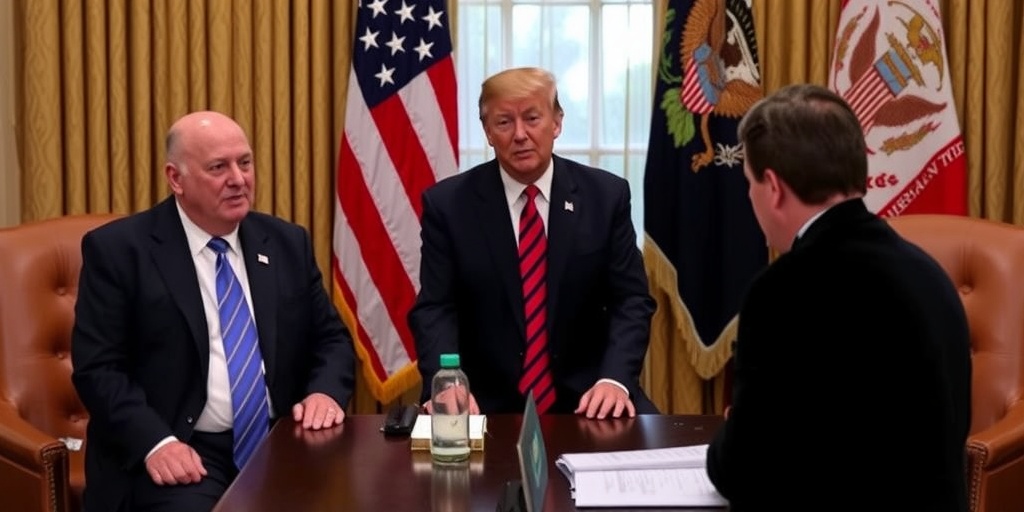Now Reading: Dozens of Government Tech Specialists Laid Off
-
01
Dozens of Government Tech Specialists Laid Off
Dozens of Government Tech Specialists Laid Off

Title: Trump Administration Cuts Jobs at Technology Group 18F, Sparking Controversy
In a significant move that underscores the Trump administration’s ongoing efforts to reduce the size of government, dozens of technology specialists at the General Services Administration (GSA) are set to lose their jobs. These specialists were part of a unit known as 18F, which was established to develop software and technology products aimed at improving the operational efficiency of various federal agencies and enhancing service delivery to the public.
The decision to terminate these employees came in an email sent over the weekend by Thomas Shedd, the head of the division overseeing 18F, who previously worked as an engineer at Tesla. In his communication, Shedd stated that 18F had been classified as a noncritical entity and would therefore be subject to cuts. “This decision was made with explicit direction from the top levels of leadership within both the administration and G.S.A.,” Shedd mentioned, hinting at the overarching control exerted by higher authorities regarding the fate of the agency.
According to letters sent to affected employees, their roles will be officially eliminated at the end of April, but they have been placed on administrative leave in the interim. This decision aligns with President Trump’s broader agenda to downsize various sectors of the federal government, a policy that has drawn both support and criticism.
In response to these layoffs, a GSA spokeswoman reaffirmed the administration’s commitment to leveraging technology that modernizes the federal government’s digital infrastructure and IT capabilities. Despite the job cuts, the statement insisted that the administration remains focused on enhancing government efficiency through technology.
The impact of 18F’s work over the years has been notable, boasting contributions to significant federal websites, including the Internal Revenue Service’s free tax filing service known as Direct File and the National Weather Service’s site, weather.gov. However, since Trump resumed his presidency, there have been growing tensions regarding the role and effectiveness of 18F, particularly following criticism from influential figures such as Elon Musk. The tech magnate, whom Trump appointed to spearhead reductions within the government, publicly claimed on his social media platform X that “that group has been deleted,” prompting further scrutiny of 18F’s functions.
18F was established during the Obama administration in 2014 in response to the troubled launch of healthcare.gov, which faced severe technical glitches upon its debut. The creation of 18F, alongside the U.S. Digital Service, aimed to provide federal agencies with in-house technology consulting to better manage costs and improve the government’s digital offerings.
In a striking turn of events, the U.S. Digital Service was also rebranded under Trump’s administration to the U.S. DOGE Service, reflecting Musk’s sweeping changes that included cutting contracts and pressuring personnel to resign. This transformation was characterized by a commitment to a leaner federal operation, although critics argue that such measures may ultimately compromise the quality and accessibility of government services.
Following the announcement of layoffs, former employees of 18F wasted no time in voicing their grievances. Within hours, they launched a website aimed at criticizing the Trump administration’s decision and expressing discontent with how their department was treated. Many of the affected workers shared that just weeks prior, they had received praise for their contributions and were regarded as the “gold standard” among civic technologists.
In early February, Shedd had acknowledged the vital role that 18F played in digitizing government functions and had underscored the value of the talent within the team. This abrupt halt to operations left employees bewildered, as they reported being unable to facilitate a smooth transition or even understand how to return government equipment. Many of them were engaged in ongoing projects to enhance the I.R.S.’s free filing software, increase accessibility to weather data through the National Oceanic and Atmospheric Administration (NOAA), and streamline passport processing—tasks that are now left in limbo.
As the fallout from this decision continues, it remains to be seen how the administration’s cuts will impact the future of technology services within the federal government and whether the objectives of efficiency and modernization will be achieved without the expertise and personnel that 18F had previously provided. The decision has drawn attention not only to the challenges faced by current government technology initiatives but also to the broader implications of political influences on the operational landscape of federal agencies.
Stay Informed With the Latest & Most Important News
Previous Post
Next Post
-
 01New technology breakthrough has everyone talking right now
01New technology breakthrough has everyone talking right now -
 02Unbelievable life hack everyone needs to try today
02Unbelievable life hack everyone needs to try today -
 03Fascinating discovery found buried deep beneath the ocean
03Fascinating discovery found buried deep beneath the ocean -
 04Man invents genius device that solves everyday problems
04Man invents genius device that solves everyday problems -
 05Shocking discovery that changes what we know forever
05Shocking discovery that changes what we know forever -
 06Internet goes wild over celebrity’s unexpected fashion choice
06Internet goes wild over celebrity’s unexpected fashion choice -
 07Rare animal sighting stuns scientists and wildlife lovers
07Rare animal sighting stuns scientists and wildlife lovers





















